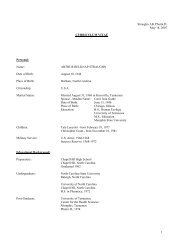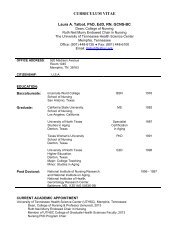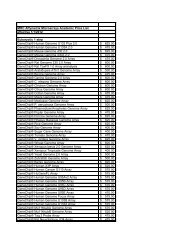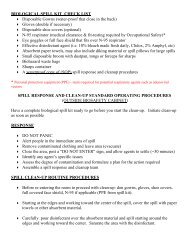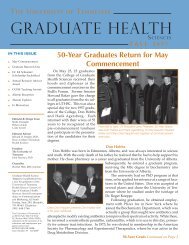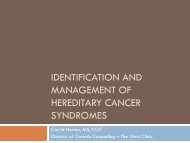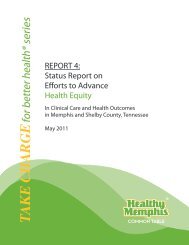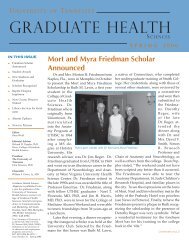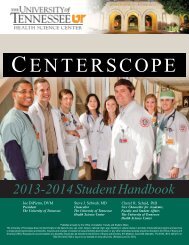Clinical Practice Guidelines for Hypothyroidism in Adults ...
Clinical Practice Guidelines for Hypothyroidism in Adults ...
Clinical Practice Guidelines for Hypothyroidism in Adults ...
You also want an ePaper? Increase the reach of your titles
YUMPU automatically turns print PDFs into web optimized ePapers that Google loves.
PRACTICE GUIDELINES FOR HYPOTHYROIDISM IN ADULTS 1207Disorders associated with hypothyroidismThe most common <strong>for</strong>m of thyroid failure has an autoimmuneetiology. Not surpris<strong>in</strong>gly, there is also an <strong>in</strong>creasedfrequency of other autoimmune disorders <strong>in</strong> this populationsuch as type 1 diabetes, pernicious anemia, primary adrenalfailure (Addison’s disease), myasthenia gravis, celiac disease,rheumatoid arthritis, systemic lupus erythematosis (17–25),and rarely thyroid lymphoma (50).Dist<strong>in</strong>ct genetic syndromes with multiple autoimmuneendocr<strong>in</strong>opathies have been described, with some overlapp<strong>in</strong>gcl<strong>in</strong>ical features. The presence of two of the threemajor characteristics is required to diagnose the syndrome ofmultiple autoimmune endocr<strong>in</strong>opathies (MAEs). The def<strong>in</strong><strong>in</strong>gmajor characteristics <strong>for</strong> type 1 MAE and type 2 MAE areas follows: Type 1 MAE: Hypoparathyroidism, Addison’s disease,and mucocutaneous candidiasis caused by mutations <strong>in</strong>the autoimmune regulator gene (AIRE), result<strong>in</strong>g <strong>in</strong>defective AIRE prote<strong>in</strong> (51). Autoimmune thyroiditis ispresent <strong>in</strong> about 10%–15% (52). Type 2 MAE: Addison’s disease, autoimmune thyroiditis,and type 1 diabetes known as Schmidt’s syndrome(53).When adrenal <strong>in</strong>sufficiency is present, the diagnosis ofsubcl<strong>in</strong>ical hypothyroidism should be deferred until afterglucocorticoid therapy has been <strong>in</strong>stituted because TSHlevels may be elevated <strong>in</strong> the presence of untreated adrenal<strong>in</strong>sufficiency and may normalize with glucocorticoid therapy(54,55) (see L-thyrox<strong>in</strong>e treatment of hypothyroidism).Signs and symptoms of hypothyroidismThe well-known signs and symptoms of hypothyroidismtend to be more subtle than those of hyperthyroidism. Dry sk<strong>in</strong>,cold sensitivity, fatigue, muscle cramps, voice changes, andconstipation are among the most common. Less commonlyappreciated and typically associated with severe hypothyroidismare carpal tunnel syndrome, sleep apnea, pituitaryhyperplasia that can occur with or without hyperprolact<strong>in</strong>emiaand galactorrhea, and hyponatremia that can occur with<strong>in</strong>several weeks of the onset of profound hypothyroidism. Although,<strong>for</strong> example, <strong>in</strong> the case of some symptoms such asvoice changes subjective (12,56) and objective (57) measuresdiffer. Several rat<strong>in</strong>g scales (56,58,59) have been used to assessthe presence and, <strong>in</strong> some cases, the severity of hypothyroidism,but have low sensitivity and specificity. While the exerciseof calculat<strong>in</strong>g cl<strong>in</strong>ical scores has been largely superseded bysensitive thyroid function tests, it is useful to have objectivecl<strong>in</strong>ical measures to gauge the severity of hypothyroidism.Early as well as recent studies strongly correlate the degree ofhypothyroidism with ankle reflex relaxation time, a measurerarely used <strong>in</strong> current cl<strong>in</strong>ical practice today (60).Normalization of a variety of cl<strong>in</strong>ical and metabolic endpo<strong>in</strong>ts <strong>in</strong>clud<strong>in</strong>g rest<strong>in</strong>g heart rate, serum cholesterol, anxietylevel, sleep pattern, and menstrual cycle abnormalities <strong>in</strong>clud<strong>in</strong>gmenometrorrhagia are further confirmatory f<strong>in</strong>d<strong>in</strong>gsthat patients have been restored to a euthyroid state (61–65).Normalization of elevated serum creat<strong>in</strong>e k<strong>in</strong>ase or othermuscle (66) or hepatic enzymes follow<strong>in</strong>g treatment ofhypothyroidism (67) are additional, less well-appreciated andalso nonspecific therapeutic endpo<strong>in</strong>ts.Measurement of T 4 and T 3T 4 is bound to specific b<strong>in</strong>d<strong>in</strong>g prote<strong>in</strong>s <strong>in</strong> serum. Theseare T 4 -b<strong>in</strong>d<strong>in</strong>g globul<strong>in</strong> (TBG) and, to a lesser extent,transthyret<strong>in</strong> or T 4 -b<strong>in</strong>d<strong>in</strong>g prealbum<strong>in</strong> and album<strong>in</strong>. S<strong>in</strong>ceapproximately 99.97% of T 4 is prote<strong>in</strong>-bound, levels ofserum total T 4 will be affected by factors that alter b<strong>in</strong>d<strong>in</strong>g<strong>in</strong>dependent of thyroid disease (Table 5) (68,69). Accord<strong>in</strong>gly,methods <strong>for</strong> assess<strong>in</strong>g (<strong>in</strong>clud<strong>in</strong>g estimat<strong>in</strong>g andmeasur<strong>in</strong>g) serum free T 4 , which is the metabolicallyavailable moiety (70), have been developed, and assessmentof serum free T 4 has now largely replaced measurement ofserum total T 4 as a measure of thyroid status. Thesemethods <strong>in</strong>clude the serum free T 4 <strong>in</strong>dex, which is derivedas the product of total T 4 and a thyroid hormone b<strong>in</strong>d<strong>in</strong>gratio, and the direct immunoassay of free T 4 after ultrafiltrationor equilibrium dialysis of serum or after addition ofanti-T 4 antibody to serum (71).A subnormal assessment of serum free T 4 serves to establisha diagnosis of hypothyroidism, whether primary, <strong>in</strong>which serum TSH is elevated, or central, <strong>in</strong> which serum TSHis normal or low (46,47). An assessment of serum free T 4(Table 6) is the primary test <strong>for</strong> detect<strong>in</strong>g hypothyroidism <strong>in</strong>antithyroid drug–treated or surgical or radioiod<strong>in</strong>e-ablatedpatients with previous hyperthyroidism <strong>in</strong> whom serum TSHmay rema<strong>in</strong> low <strong>for</strong> many weeks to months.In monitor<strong>in</strong>g patients with hypothyroidism on L-thyrox<strong>in</strong>ereplacement, blood <strong>for</strong> assessment of serum free T 4 should becollected be<strong>for</strong>e dos<strong>in</strong>g because the level will be transiently<strong>in</strong>creased by up to 20% after L-thyrox<strong>in</strong>e adm<strong>in</strong>istration (72).In one small study of athyreotic patients, serum total T 4 levels<strong>in</strong>creased above basel<strong>in</strong>e by 1 hour and peaked at 2.5 hours,while serum free T 4 levels peaked at 3.5 hours and rema<strong>in</strong>edhigher than basel<strong>in</strong>e <strong>for</strong> 9 hours (72).In pregnancy, measurement of serum total T 4 is recommendedover direct immunoassay of serum free T 4 . Becauseof alterations <strong>in</strong> serum prote<strong>in</strong>s <strong>in</strong> pregnancy, directimmunoassay of free T 4 may yield lower values based onreference ranges established with normal nonpregnant sera.Moreover, many patients will have values below the nonpregnantreference range <strong>in</strong> the third trimester, <strong>in</strong>clud<strong>in</strong>gTable 5. Factors That Alter Thyrox<strong>in</strong>eand Triiodothyron<strong>in</strong>e B<strong>in</strong>d<strong>in</strong>g <strong>in</strong> SerumIncreased TBG Decreased TBG B<strong>in</strong>d<strong>in</strong>g <strong>in</strong>hibitorsInherited Inherited SalicylatesPregnancy Androgens FurosemideNeonatal state Anabolic steroids Free fatty acidsEstrogens Glucocorticoids Phenyto<strong>in</strong>Hepatitis Severe illness Carbamazep<strong>in</strong>ePorphyria Hepatic failure NSAIDs (variable,Hero<strong>in</strong>Nephrosistransient)Methadone Nicot<strong>in</strong>ic acid Hepar<strong>in</strong>Mitotane L-Asparag<strong>in</strong>ase5-FluorouracilSERMS (e.g.,tamoxifen,raloxifene)Perphanaz<strong>in</strong>eTBG, T 4 -b<strong>in</strong>d<strong>in</strong>g globul<strong>in</strong>; SERMS, selective estrogen receptormodulators; NSAIDs, nonsteroidal anti-<strong>in</strong>flammatory drugs.




